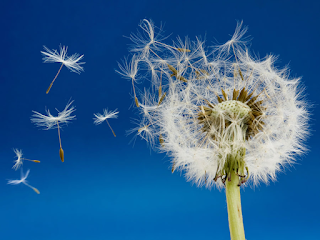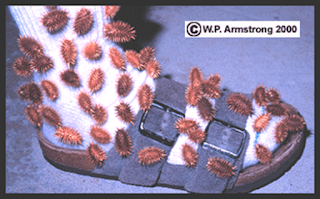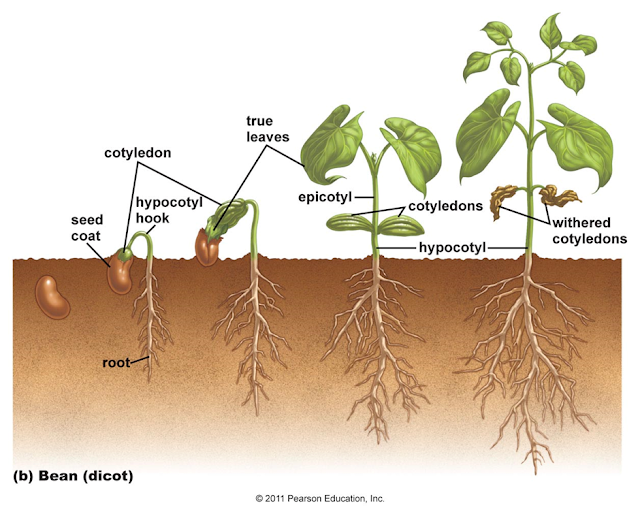The flowering plants or angiosperm have reproductive structures found within, structures called flowers and the seeds, while developing and enclosed within a fruit. Flowers are organs which are specialized for sexual reproduction. Despite the different shapes and sizes of flowers, they are all made up of similar parts.
FLOWER STRUCTURE
The flower is made up of rings of modified leaves on a specialized stem. The pedicel supports the flower and connects it to the stem of the plant. The larger end of the pedicel is called the receptacle to which the other parts are attached. Sepals are leaf-like structures that form a ring around the base of the flower. They enclose and protect the flower bud before it blossoms. Sepals can be small and green or large and brightly coloured. The calyx is a complete cycle of sepals. Above the sepals are petals, which in some flowers are white and in others they are brightly coloured. The corolla forms the complete circle of petals. The petals surround the reproductive organs of the flower.

In the centre of the flower is where the reproductive organs are situated. They include the stamens and the pistil. The stamens are usually called the male reproductive organs, located inside the corolla. The stamen is often made up of two parts namely the stalk-like filament and a saclike structure called the anther at the tip of the filament. A flower may contain one or more stamens. Pollen is produced within the anthers.
The female reproductive organ of the angiosperm is referred as the pistil. A flower may have one or more pistils. It is situated in the centre of the flower and is made up of three parts. The stigma is the enlarged top area of the pistil and it function is to receives pollen. Then in the middle way is the style which supports the stigma. The ovary is at the base of the pistil and contains the ovules. The ovary develops into a fruit while the ovules develop into seeds.
Stamens and pistils are essential organs of the flower. The corolla and calyx are accessory organs. Some flowers contain stamens, pistil, corolla, and calyx, while in others one or more structures are missing. Pistillate flowers (female plants) contain pistils without stamens, and staminate flowers (male plants) contain stamens but no pistils. However, some plants contain both Pistillate and staminate flowers.
There are two basic types of reproduction; asexual and sexual. Asexual reproduction results from one parent giving rise to new individuals which are genetically identical to it. The genetically identical individuals produced are called clones.
Sexual reproduction results from two parents (sex cells fusing) giving rise to new individuals. Off springs acquire genes from each parent and are therefore genetically different from one another and from their parents. Sex cells are called gametes. The flowers are the reproductive structures on a plant. Flowers that possess both male and female organs are called hermaphrodites.
We can look at the four stages of sexual reproduction in plants-pollination, fertilization, seeds formation and fruits, and dispersal.
Pollination
The male pollen grains transfer from the anthers, where they are made, to the stigma (female part) of the same or different flower. All seed plants have pollination as part of their reproductive cycle. In angiosperm, pollination is the transfer of pollen from an anther to the stigma. Pollination takes many forms for different plants; self-pollination, cross pollination and artificial pollination.
Self-pollination is the transfer or fall of pollen grains from an anther to a stigma on the same plant. Usually insects bring about self-pollination of a flower by transferring pollen from the anther to the stigma in the same flower.
Cross pollination is the transfer of pollen grains from the anther of one plant to the stigma of another plant. There two agents of cross pollination are insects and wind. Flying insects, visit flowers to collect sugary liquid called nectar produced at the base of the flower. Pollen grains from the flower’s anther stick to hairs on the insect and are carried to the stigma of a flowers of another plant of the same species. Insect pollinated flowers have certain adaptations to attract the insects and to aid pollen transfer. Some of them are:
• Flowers are large, scented and have brightly coloured petals.
• Nectar is produced.
• Pollen is produced in quite small quantities, but it is rough and sticky and large to help it stick to an insect’s hairs.
• Anthers are enclosed inside the flower to increase the chance of the insect brushing against them.
• Stigma is stick so that pollen will not be dislodged once deposited by an insect.
• Petals sometimes have convenient shape for an insect’s easy access
Cross pollination by wind mostly take place in plants such as grass family, which include wheat, maize, rice, sorghum, and millet. Some trees such as pine also are pollinated by wind. Wind pollinated flowers have the following adaptations to help pollen movement.
• Flowers are usually small and lack scent.
• Petals are insignificant and often colourless.
• Nectar is usually absent. ‘
• Anthers dangling on long, hanging filaments allow the pollen to be scattered by wind.
• Stigmas are feathery and hang out of the flower to trap passing pollen being carried by wind.
• Pollen is dry and dusty and produced in large quantities and is much smaller and lighter than pollen produced by insect-pollinated flowers.
Artificial pollination takes place when pollen is intentionally transferred by humans from one plant to another. It is used in plant breeding to produce plants with specific traits.
If a flower has not been pollinated, a fruit does not form, and usually the flower withers and falls off.
Fertilization
When pollen grains reach the stigma of a flower, it germinates. The protective coat of the pollen grain breaks open. A pollen tube grows down through the stigma and style and into the ovary. It then enters the ovule through the micropyle. The tube nucleus dies and the two male nuclei pass down the pollen tube and enter the embryo sac. There, one nucleus fuses with the egg nucleus. A male sex cell from a pollen grain and a female sex cell fuse or join to form a diploid zygote. The other sperm nucleus fuses with the two polar nuclei, forming a triploid (3n) cell that develops into endosperm. This process is called double fertilization. Endosperm is the tissue that stores food for the developing plant embryo.
Fruits and seed formation
After fertilization, each ovule develops into a seed inside the ovary, and the ovary develops into a fruit. The embryo plant and its store of food inside are the covered by a tough seed coat called the testa. A fertilized ovule is a seed. In angiosperms, the seeds are always found within the fruit, which protects them. The parts of the flower not involved in the formation of the fruit wither and die. The wall of the ripened ovary may be hard or soft, dry or freshy, and may be made of several separate layers.
Fruits are classified according to their origin of formation. A simple fruit develop from a single ovary such as grapefruit, cherries and tomatoes. Aggregate fruit is another type of fruit developing from many ovaries found in a flower. Examples of aggregate fruits are raspberries and strawberries. Then a multiple fruit results from the fusing of simple fruits of many separate flowers, such as in pineapple plants.
The seed is made up of the seed coat, the embryo and endosperm. The wall of the ovule develops into a tough, protective seed coat and on the outside of the seed coat is a scar called the hilum which marks where the ovule was attached to the ovary.
Dispersal
Reproduction is only complete when the seeds leave the ovary and are carried away from the parent plant. This is called seed dispersal. The three main ways of dispersal are by wind, water and by animals. The scattering or dispersal of seeds from the parent plant is important to the survival of the species. Plants that grow too close together must compete for water, minerals, and sunlight. In some plants, pressure develops within the drying fruit. When the fruit bursts, seeds are released with enough force to scatter them over a large area. A Lupin plant is an example of a plant which splits open and ejects the seeds.
Many seeds and single seeded fruits such as those of dandelion, milkweed and sycamore are light. This type of seeds can be carried great distances by the wind. For the Sycamore tree, the fruits ‘wings’ helps the seed to be carried with wind.

Others such as the coconut float and are carried by water because they are light and are covered in tough water- proof covers.
There are also some seeds or fruits that have hooks such as the black jack. When an animal brushes against them, they attach to the fur of the animal or even clothes of people, and are carried away from the parent plant.

In addition, animals such as birds and some mammals eat sweet, freshy fruits. The seeds are usually indigestible and are later deposited with other digestive wastes some distance away from the parent plant. In addition, they should be resistant to chemicals in the digestive tract.
Seed structure
The seed or ripened ovule is made up of the seed coat, the embryo, and endosperm. On the outside of the seed coat there is a scar called the “hilum” which is the mark where the ovule was attached to the ovary. The nutrients stored in the endosperm cells’ come from the parent plant. All angiosperm embryos have at least one seed leaf, or cotyledon. The seeds of one group of angiosperms have only one cotyledon, and the plants that grow from these seeds are called monocots. The others have two cotyledons and are called dicots. You can identify other monocots and dicots by some other features as summarized below:
| MONOCOTS | DICOTS | ||
| One cotyledon | Seed leavescotyledon | Two | |
| Parallel veins | Leaf venationveins | Network | |
| Bundles scattered | Stemsin rings | Bundles | |
| Flower parts usually in threes | Flowersand fives | Flower parts usually in fours | |
In addition to the cotyledons, the plant embryo has three parts: the epicotyl, hypocotyl, and radical. Epicotyls are the point of attachment of the cotyledons. It usually gives rise to the terminal bud, leaves, and upper part of the stem of a young plant. The hypocotyl is the part of the embryo below the point of attachment of the cotyledons but above the radical. The radical is the lowest part of the embryo, the embryonic root.
Seed germination
For a seed to germinate it requires the following:
• Water
• Oxygen
• Proper temperature.
• Light for some seeds
Main seeds go in a state of dormancy, which is a resting period before they can begin to grow.

Tropism
Tropism is the growth of a plant in a specific direction in response to a stimulus. Tropisms may be positive or negative. A positive tropism is a growth movement of a plant toward a stimulus while a negative tropism is movement away from a stimulus. The following are kinds of stimuli that plants respond to positively or negatively: light (phototropism), gravity (geotropism), and water (hydrotropism). A stimulus of touch (thigmotropism) exists in some plants! The parts of the plants that respond to these stimuli positively or negatively are roots and stems. For example roots grow away from light as such they show negative phototropism while the stem grow towards light and this is positive phototropism. Roots grow towards water and gravity showing positive hydrotropism and positive geotropism respectively. For positive hydrotropism, a good example of such a plant is willow trees. Grapevine and some other plants wind themselves around the stems of other plants showing positivethigmotropism.
It is worth noting here that a chemical in plants called auxin is responsible for these growth movements in plants. It is thought that the auxin is unevenly distributed in the affected plant areas.
Plant growth and requirements
All types of organisms have adaptations that allow them to survive in a particular environment. Adaptation varies as some show adaptation for getting food and for reproduction. Plants like animals are affected by physical factors in their environment, such as amount of water available, temperature changes, and even the composition of the soil.
To grow well and health, plants need three things;
• A continuous supply of clean air
• Light
• Water
• Mineral salts in the soil
Provision of air and light is not a problem on this part of the earth. For example, the energy for almost all living things on planet earth is obtained directly or indirectly from the sun. The intensity and duration of sunlight affect the growth and flowering of plants. Some plants are said they require high light intensity while others require low light intensity.
Precipitation is the release of water from the atmosphere as rain, snow, dew, and fog. We know very well that amount of precipitation per year vary from one part of the world to another. We have already discussed the importance of water in plants.
Soil consists of inorganic and organic materials. Inorganic material like weathered rock contains soluble minerals which dissolve in water. The minerals present in soil depend partly on the type of rock from which the soil was formed and partly from the types of organisms living in the soil.
